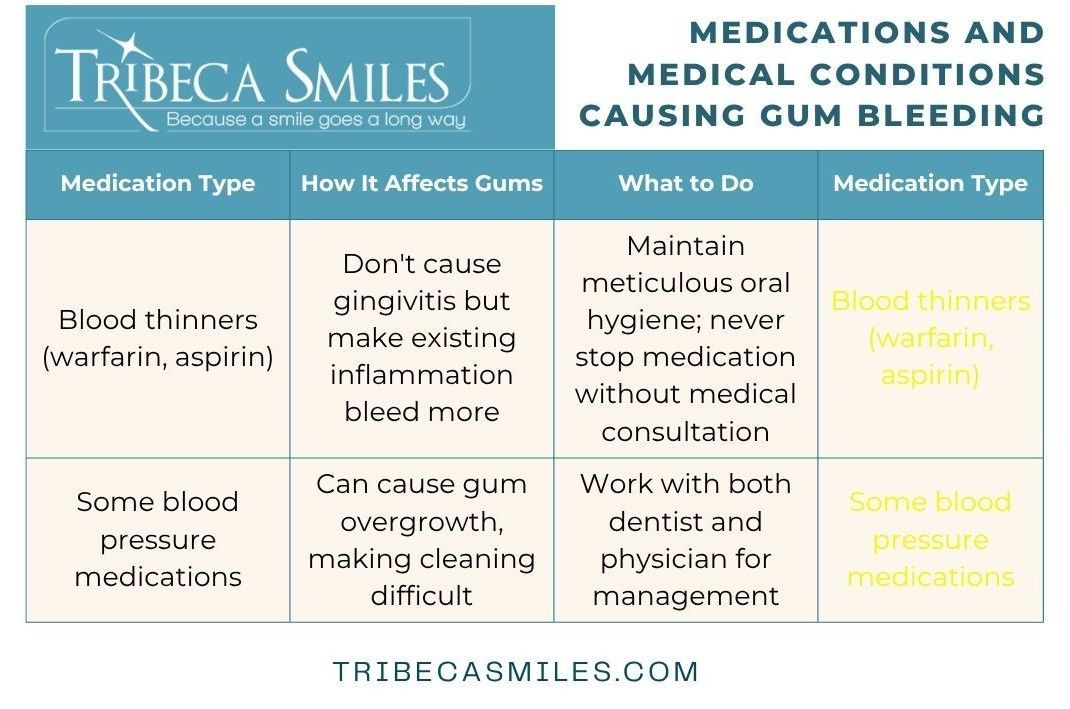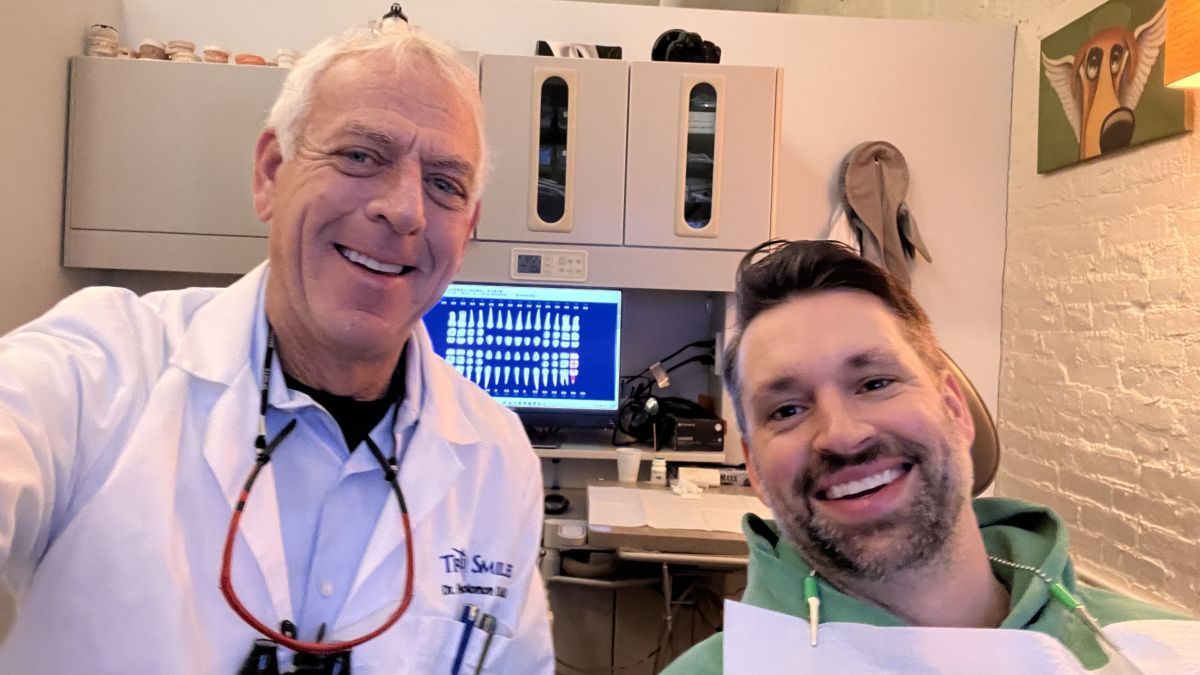Why Are My Gums Bleeding When I Brush and Floss?
Key Takeaways
- Bleeding gums when brushing and flossing typically signals gingivitis, an early and reversible form of gum disease caused by plaque buildup
- Professional dental cleaning combined with proper home care can stop bleeding gums within 2-3 weeks
- Persistent bleeding after two weeks requires professional evaluation as it may indicate periodontitis or systemic health issues
| Table of Contents |
|---|
| 1. Understanding Why Your Gums Bleed During Oral Hygiene |
| 2. Gingivitis: The Most Common Cause of Bleeding Gums |
| 3. Beyond Gingivitis: Other Reasons Your Gums May Bleed |
| 4. How to Stop Bleeding Gums: Your Action Plan |
| 5. When Bleeding Gums Signal Something More Serious |
| 6. Professional Treatment for Bleeding Gums at Tribeca Smiles |
| 7. Prevention: Maintaining Healthy Gums Long-Term |
| 8. Frequently Asked Questions About Bleeding Gums |
If you've ever spit pink into the sink after brushing, you're not alone. Bleeding gums when brushing affects millions of Americans, yet many dismiss it as normal wear and tear from their toothbrush.
Here's the truth: healthy gums don't bleed. When your gums bleed during routine oral hygiene, they're sending you an important message about your oral health that shouldn't be ignored.

Understanding Why Your Gums Bleed During Oral Hygiene
Your gums are designed to withstand the gentle pressure of proper brushing and flossing. They have a firm, coral-pink appearance and fit snugly around each tooth, creating a protective barrier against bacteria.
So why do they gums sometimes bleed?
The answer usualy lies in the thin layer of bacteria that constantly forms on your teeth - dental plaque. This sticky biofilm isn't just leftover food; it's a complex community of bacteria that produce acids and toxins.
When plaque accumulates along the gumline, your body responds with inflammation. Blood vessels in the gums become fragile and dilated, making them prone to bleeding with even gentle brushing.
Think about it this way: the bleeding isn't from your toothbrush injuring healthy tissue. Instead, it's revealing tissue that's already compromised by bacterial irritation. The mechanical action of brushing simply triggers what the underlying inflammation has set up.
Gingivitis: The Most Common Cause of Bleeding Gums
When we talk about gum inflammation from plaque buildup, we're describing gingivitis - the earliest stage of gum disease. If you're experiencing swollen and bleeding gums, gingivitis is likely the culprit.
The good news? It's completely reversible with proper care.
How Gingivitis Develops
The process starts simply enough. Miss a few spots while brushing, skip flossing for a few days, and plaque begins accumulating at the gumline. Within 24-72 hours, this soft plaque starts absorbing minerals from your saliva, hardening into tartar (also called calculus).
Unlike plaque, which you can remove with your toothbrush, tartar bonds firmly to your teeth. Its rough surface provides an ideal foundation for more plaque to accumulate, creating a vicious cycle. Your gums respond with classic signs of inflammation:
- Redness and puffiness
- Tenderness when touched
- Bleeding during brushing or flossing
- Bad breath that doesn't improve after brushing
At this stage, the damage remains confined to your soft gum tissue. The bone and connective fibers supporting your teeth haven't been affected yet.
That's why regular professional cleanings at our Tribeca office are so crucial - they remove the tartar your toothbrush can't touch, giving your gums a chance to heal completely.
The Critical Window for Treatment
Research shows that untreated gingivitis can progress to periodontitis in as little as a few months, though the timeline varies between individuals. Some people might maintain gingivitis for years without progression, while others advance rapidly to more serious gum disease. Factors like smoking, diabetes, and genetics influence this progression rate.
Beyond Gingivitis: Other Reasons Your Gums May Bleed
While plaque-induced gingivitis causes most cases of bleeding gums, several other factors can trigger or worsen the problem. Understanding these helps you identify when bleeding might signal something beyond basic gum inflammation.
Aggressive Brushing and Wrong Tools
Ever noticed your toothbrush bristles splaying outward after just a few weeks? That's a telltale sign you're brushing too hard. Many people believe scrubbing harder means cleaner teeth, but aggressive brushing can directly traumatize healthy gum tissue, causing recession and bleeding.
The American Dental Association recommends using only soft-bristled toothbrushes. Medium or hard bristles might feel like they're cleaning better, but they can actually damage both gums and tooth enamel. Combined with aggressive technique, they turn oral hygiene from helpful to harmful.
Vitamin Deficiencies That Affect Your Gums
Your gums need specific nutrients to maintain their structure and healing capacity:
Vitamin C deficiency weakens the collagen that holds your gum tissue together. Without adequate vitamin C, capillaries become fragile and gums take on a spongy, purple appearance. Severe deficiency leads to scurvy, but even mild insufficiency increases bleeding tendencies.
Vitamin K deficiency impairs your blood's ability to clot properly. Since vitamin K activates clotting factors in your liver, inadequate levels mean even minor capillary breaks in your gums result in prolonged bleeding.
Medications and Medical Conditions
Certain medications directly impact gum health or bleeding tendency:

Medical conditions like diabetes significantly increase periodontal disease risk. High blood sugar feeds harmful bacteria while impairing your immune response. The relationship works both ways - treating gum disease often improves blood sugar control.
Hormonal Changes Throughout Life
Hormone fluctuations make gums more reactive to plaque. During pregnancy, up to 70% of women develop pregnancy gingivitis between months two and eight. The surge in progesterone and estrogen increases blood flow to gums and alters the immune response to bacteria.
Similar patterns occure during puberty, menstruation, and menopause. The key isn't that hormones cause gum disease - they amplify your gums' response to existing plaque.
How to Stop Bleeding Gums: Your Action Plan
Reversing bleeding gums requires a systematic approach targeting the root cause while promoting healing. Here's your step-by-step strategy:
Step 1: Perfect Your Technique
Position your soft-bristled toothbrush at a 45-degree angle to your gumline. Use gentle, circular motions - think massage, not scrubbing. Each tooth should get individual attention for about 10 seconds, totaling two minutes for your entire mouth.
For flossing, use 18 inches of floss wound around your middle fingers. Guide it gently between teeth using a rubbing motion. Once at the gumline, curve the floss into a C-shape against one tooth, sliding it into the space between gum and tooth. Move it up and down several times before repeating on the adjacent tooth.
Don't stop if you see blood initially - this confirms you're cleaning areas that need it most. With consistent daily flossing, bleeding should stop within 3-10 days as inflammation resolves.
Step 2: Add Therapeutic Rinses
While mechanical cleaning remains paramount, antimicrobial rinses provide additional bacteria control. A simple saltwater rinse (1/2 teaspoon salt in 8 ounces warm water) helps reduce bacteria and soothe inflamed tissue. Swish for 30 seconds after meals.
Over-the-counter antiseptic mouthwashes containing essential oils offer proven gingivitis reduction when used alongside brushing and flossing. Remember - rinses supplement but never replace mechanical plaque removal.
Step 3: Schedule Professional Treatment
If bleeding persists beyond two weeks of improved home care, professional intervention becomes essential. AtTribeca Smiles, our comprehensive approach begins with removing all tartar deposits through scaling. For early gingivitis, a routine cleaning often suffices. More advanced cases may require deep cleaning (scaling and root planing) to address bacteria below the gumline.
Dr. Frederick Solomon, combines advanced diagnostic technology with personalized treatment planning. Using our Dentri-Max 3D imaging system, we can precisely evaluate bone levels and identify areas needing focused attention.
When Bleeding Gums Signal Something More Serious
The two-week rule serves as your guideline: bleeding continuing beyond two weeks of proper home care requires professional evaluation. But certain symptoms demand immediate attention regardless of timeframe.
Red Flags Requiring Urgent Care
Watch for these warning signs of advancing periodontal disease:
- Gum recession making teeth appear longer
- Persistent bad breath that doesn't improve with brushing
- Loose teeth or changes in how teeth fit together
- Pus between teeth and gums
- Deep red or purple gum coloration
- Spontaneous bleeding without brushing or flossing
These symptoms suggest progression from reversible gingivitis to periodontitis, where permanent damage to supporting bone occurs.
The Systemic Health Connection
Research reveals striking connections between gum disease and overall health. The chronic inflammation of periodontitis doesn't stay confined to your mouth - inflammatory markers circulate throughout your body, contributing to:
Cardiovascular disease: People with periodontitis face two to three times higher risk of heart attack and stroke. The inflammatory burden from gum disease accelerates atherosclerosis.
Diabetes complications: Gum disease makes blood sugar harder to control, while high blood sugar worsens gum infections - creating a destructive cycle.
Pregnancy complications: Maternal periodontitis links to increased risk of preterm birth and low birth weight.
These connections elevate treating bleeding gums from a dental issue to a medical priority.

Professional Treatment for Bleeding Gums at Tribeca Smiles
When home care isn't enough, our comprehensive treatment options address every stage of gum disease. Dr. Solomon's expertise in both restorative dentistry and periodontal health ensures you receive appropriate care for your specific needs.
Our Treatment Approach
Initial evaluation includes digital imaging and careful measurement of pocket depths around each tooth. This establishes your baseline and guides treatment planning.
Professional cleaning removes all plaque and tartar deposits. For gingivitis, this might be all that's needed. We'll also identify any contributing factors like rough fillings that trap plaque.
Deep cleaning procedures become necessary when bacteria penetrate below the gumline. Using ultrasonic instruments and hand scalers, we thoroughly clean root surfaces, allowing gums to reattach firmly.
Ongoing maintenance prevents recurrence. We'll recommend a cleaning frequency matching your individual risk level - typically every 3-6 months for patients with a history of gum disease.
For anxious patients, we offer nitrous oxide sedation to ensure comfortable treatment. Same-day emergency appointments are available for urgent gum problems.
Prevention: Maintaining Healthy Gums Long-Term
Preventing bleeding gums proves far easier than treating advanced gum disease. These strategies keep your gums resilient:
Daily Habits That Make the Difference
- Brush twice daily for two minutes using proper technique
- Floss daily, especially before bedtime when saliva production decreases
- Replace your toothbrush every 3-4 months or when bristles fray
- Stay hydrated to maintain protective saliva flow
Dietary Support for Gum Health
Focus on foods that strengthen gum tissue and fight inflammation:
- Vitamin C sources: Bell peppers, strawberries, broccoli, citrus fruits
- Calcium-rich options: Yogurt, cheese, leafy greens
- Anti-inflammatory foods: Fatty fish, green tea, nuts
- Crunchy vegetables: Carrots, celery stimulate saliva and naturally clean teeth
Limit sugary snacks and acidic beverages that feed harmful bacteria. When you do indulge, rinse with water afterward to neutralize acids.
Regular Professional Care
Even meticulous home care can't prevent all tartar formation. Professional cleanings remain essential for long-term gum health. Signs you might need a cleaning sooner include persistent bad breath, visible tartar buildup, or any bleeding during brushing.
Frequently Asked Questions About Bleeding Gums
How long before bleeding gums heal after starting treatment?
With proper daily care and professional cleaning, most cases of gingivitis-related bleeding resolve within 2-3 weeks. Initial improvement often appears within 3-10 days of consistent flossing.
Can bleeding gums heal without seeing a dentist?
Mild gingivitis might improve with excellent home care, but tartar requires professional removal. If bleeding persists beyond two weeks, professional evaluation becomes necessary to rule out periodontitis or systemic issues.
Is it normal for gums to bleed when starting to floss again?
Yes, initial bleeding when resuming flossing indicates existing gingivitis in those neglected areas. Continue gentle daily flossing - the bleeding should stop within a week as inflammation resolves.
Can stress cause bleeding gums?
Chronic stress weakens your immune response to bacterial plaque and often leads to neglected oral hygiene. While stress doesn't directly cause bleeding, it significantly increases your susceptibility to gum disease.
Should I use mouthwash for bleeding gums? Antimicrobial mouthwash helps control bacteria but doesn't replace brushing and flossing. Use it as a supplement to mechanical cleaning, not a substitute.
Call today or book online to take the first step toward healthy, bleeding-free gums.



